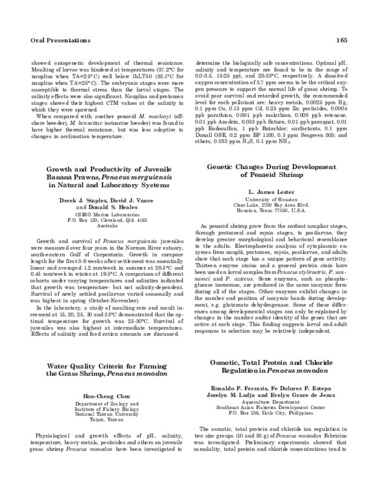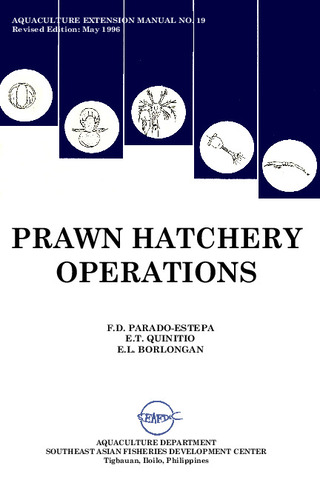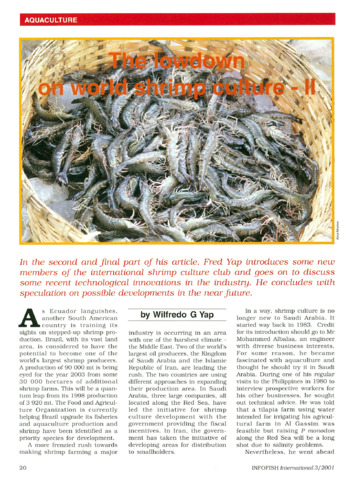Water quality criteria for farming the grass shrimp, Penaeus monodon
Share
Abstract
Physiological and growth effects of pH, salinity, temperature, heavy metals, pesticides and others on juvenile grass shrimp Penaeus monodon have been investigated to
determine the biologically safe concentrations. Optimal pH, salinity and temperature are found to be in the range of 8.0-8.5, 15-25 ppt, and 28-33°C, respectively. A dissolved oxygen concentration of 3.7 ppm seems to be the critical oxygen pressure to support the normal life of grass shrimp. To avoid poor survival and retarded growth, the recommended level for each pollutant are: heavy metals, 0.0025 ppm Hg, 0.1 ppm Cu, 0.15 ppm Cd, 0.25 ppm Zn; pesticides, 0.0004 ppb parathion, 0.001 ppb malathion, 0.008 ppb rotenone, 0.01 ppb Azodrin, 0.033 ppb Saturn, 0.01 ppb paraquat, 0.01 ppb Endosulfan, 1 ppb Butachlor; surfactants, 0.1 ppm Dunall OSE, 0.2 ppm BP 1100, 0.5 ppm Seagreen 805; and others, 0.033 ppm H2S, 0.1 ppm NH3.
Description
Abstract only.
Suggested Citation
Chen, H.-C. (1985). Water quality criteria for farming the grass shrimp, Penaeus monodon (Abtract only). In Taki Y., Primavera J.H. and Llobrera J.A. (Eds.). Proceedings of the First International Conference on the Culture of Penaeid Prawns/Shrimps, 4-7 December 1984, Iloilo City, Philippines (p.165). Iloilo City Philippines: Aquaculture Department, Southeast Asian Fisheries Development Center.
Taxonomic term
Related items
Showing items related by title, author, creator and subject.
-
An overview of the nutrition, feed and feeding techniques of prawn penaeid/shrimps
Piedad-Pascual, Felicitas (Philippine Council for Aquatic and Marine Research and Development, 1989)This paper echoes what transpired during the first International Conference of Penaeid Prawns/Shrimps held in Iloilo City in December 4-7, 1984, particularly on the Nutrition nd Feed Development. Around 25 papers were ... -
Prawn hatchery operations
Parado-Estepa, Fe D.; Quinitio, Emilia T.; Borlongan, Emeterio L. (Aquaculture Department, Southeast Asian Fisheries Development Center, 1996-05)The manual, an updated version of the 1984 SEAFDEC/AQD manual, presents the underlying principles and step-by-step instructions of prawn larval and post-larval rearing. The techniques described are not only applicable to ... -
The lowdown on world shrimp culture - II
Yap, Wilfredo G. (INFOFISH, 2001)This paper introduces some new members of the international shrimp culture club and goes on to discuss some recent technological innovations in the industry, particularly the polyculture of tilapia (mainly Oreochromis ...





